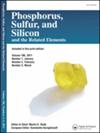A novel process approach of a circular economy practice in the production of hydroxyapatite from phosphogypsum
IF 1.4
4区 化学
Q4 CHEMISTRY, INORGANIC & NUCLEAR
Phosphorus, Sulfur, and Silicon and the Related Elements
Pub Date : 2024-09-02
DOI:10.1080/10426507.2024.2410867
引用次数: 0
Abstract
Phosphogypsum (PG), a by-product of phosphate fertilizer industry, is chemically impure gypsum (CaSO4 · 2 H2O) containing phosphate residues. Provided by the calcium and phosphorus content, PG can be considered as a precursor for synthetic hydroxyapatite (s-HAp) production. This study proposes a two-step alkali route for s-HAp production from PG. Resulting samples were characterized by ICP-OES, SEM, XRD and FT-IR analyses in comparison with bone ash (BA) sample. Ca/P ratio (wt%) was determined as 2.46 and 2.78 for s-HAp and BA samples, respectively. SEM analysis showed the uniform distribution of spherical shaped particles in BA samples; however s-HAp particles showed irregular distribution of nearly spherical-like particles agglomerated as platelets on the surface. XRD analysis indicated that s-HAp particles possessed low crystallinity and ICDD references showed the appearance of apatite-CaOH phases. FT-IR spectrum showed the vibration bands of PO43− bands in the range of 1018–601 cm−1. According to characterization analyses, s-HAp samples show lower Ca/P ratio, irregular morphology, and low crystallinity due to possible impurities. Thus, further downstream operations regarding to impurity removal should be employed to develop a promising route to synthetic HAp production and employ a CE approach on industrial scale to evaluate s-HAp samples as a commercial substitute to BA.
磷石膏生产羟基磷灰石循环经济实践的新工艺途径
磷石膏(PG)是磷肥工业的副产物,是化学上不纯的石膏(CaSO4·2h2o),含有磷酸渣。由钙和磷含量提供,PG可以被认为是合成羟基磷灰石(s-HAp)生产的前体。本研究提出了一种两步法碱法从PG中生产s-HAp的方法,并对所得样品进行了ICP-OES、SEM、XRD和FT-IR分析,与粉煤灰(BA)样品进行了比较。s-HAp和BA样品的Ca/P比值(wt%)分别为2.46和2.78。SEM分析表明,BA样品中球形颗粒分布均匀;s-HAp颗粒呈不规则分布,表面呈血小板状聚集。XRD分析表明,s-HAp颗粒结晶度较低,ICDD参考文献显示为磷灰石- caoh相。FT-IR光谱显示PO43−的振动带在1018 ~ 601 cm−1范围内。根据表征分析,s-HAp样品表现出较低的Ca/P比,不规则的形貌,以及由于可能存在杂质而导致的低结晶度。因此,应该采用进一步的下游操作来去除杂质,以开发有前途的合成HAp生产路线,并在工业规模上采用CE方法来评估s-HAp样品作为BA的商业替代品。
本文章由计算机程序翻译,如有差异,请以英文原文为准。
求助全文
约1分钟内获得全文
求助全文
来源期刊
CiteScore
2.60
自引率
7.70%
发文量
103
审稿时长
2.1 months
期刊介绍:
Phosphorus, Sulfur, and Silicon and the Related Elements is a monthly publication intended to disseminate current trends and novel methods to those working in the broad and interdisciplinary field of heteroatom chemistry.

 求助内容:
求助内容: 应助结果提醒方式:
应助结果提醒方式:


